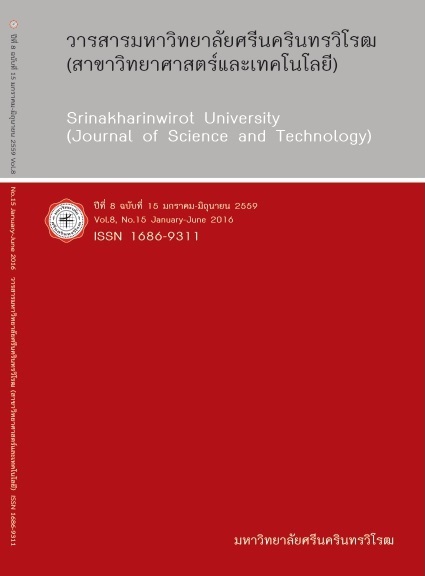สบู่ต้านเชื้อแบคทีเรียจากสารสกัดหยาบจากผลมะขามป้อม ANTIBACTERIAL SOAPS CONTAINING THE CRUDE EXTRACTS OF PHYLLANTHUS EMBLICA LINN. FRUITS
Keywords:
สบู่ต้านเชื้อแบคทีเรีย มะขามป้อม สกัดAbstract
บทคัดย่อ
งานวิจัยนี้ได้ศึกษาการสกัดผลมะขามป้อมซึ่งเป็นพืชสมุนไพรที่พบมากในประเทศไทย รวมถึงตรวจสอบฤทธิ์ต้านแบคทีเรียของสารสกัดหยาบจากผลมะขามป้อม เตรียมสบู่ที่มีส่วนผสมของสารสกัดหยาบและทดสอบคุณสมบัติด้านกายภาพ ด้านเคมี และการต้านเชื้อแบคทีเรียของสบู่ ขั้นตอนการสกัดเริ่มจากการอบแห้งผลมะขามป้อมสดและบดเป็นผงแล้วนำมาสกัดโดยเมทานอล จากนั้นนำสารสกัดหยาบจากเมทานอลมาแยกชั้นต่อด้วยตัวทำละลายได้แก่ ไดเอทิลอีเทอร์ เอทิลอะซีเตต และบิวทานอล ตามลำดับ สารสกัดในตัวทำละลายแต่ละชั้นจะนำไปศึกษาฤทธิ์ต้านแบคทีเรียโดยวิธี agar diffusion โดยทดสอบกับแบคทีเรียสองชนิดคือ Escherichia coli และ Staphylococcus aureus พบว่าสารสกัดชั้นไดเอทิลอีเทอร์แสดงคุณสมบัติต้านเชื้อแบคทีเรียดีกว่าชั้นเอทิลอะซีเตตและบิวทานอลตามลำดับ ร้อยละผลผลิตของสารสกัดชั้นบิวทานอลมีค่ามากกว่าชั้นเอทิลอะซีเตตและไดเอทิลอีเทอร์ ตามลำดับ จากนั้นเตรียมสบู่จากน้ำมันปาล์มผสมน้ำมันดอกทานตะวัน และเติมสารสกัดชั้นเอทิลอะซีเตตและบิวทานอลที่ความเข้มข้น 5%, 7.5% และ 10% โดยน้ำหนัก แล้วนำไปศึกษาฤทธิ์ต้านเชื้อแบคทีเรียอีกครั้ง พบว่าความเข้มข้นน้อยที่สุดที่สามารถยับยั้งเชื้อแบคทีเรียทั้งสองชนิดได้คือสบู่ที่ผสมสารสกัด 5% สำหรับทั้งชั้นเอทิลอะซีเตตและบิวทานอล นอกจากนี้สบู่ดังกล่าวยังมีคุณสมบัติทางกายภาพและทางเคมีผ่านเกณฑ์มาตรฐานผลิตภัณฑ์ชุมชน ประเภทสบู่ก้อน (มผช. 94-2546) และมาตรฐานผลิตภัณฑ์อุตสาหกรรม ประเภทสบู่ที่เติมสารระงับเชื้อ (มอก. 29-2545)
Abstract
This research aims to study the extraction of Indian gooseberry (Phyllanthus emblica Linn.) fruit, a local herb in Thailand, and investigate an antibacterial activity of the crude extracts. Soaps containing the crude extracts were prepared and tested for the physical, chemical, and antibacterial properties. Firstly, the fresh gooseberry fruits were dried and grounded. The obtained powders were extracted by methanol. The methanolic extracts were then partitioned by diethyl ether, ethyl acetate, and butanol, respectively. Each fraction was studied for the antibacterial activity by agar diffusion method. Two kinds of microbial were used including Escherichia coli and Staphylococcus aureus. The diethyl ether fraction showed the highest antibacterial activity, followed by the ethyl acetate and butanol fractions, respectively. The percent yield of the butanol fraction was higher than that of the ethyl acetate and diethyl ether fractions, respectively. Either the ethyl acetate or butanol fractions were then loaded into the soap at the concentrations of 5%, 7.5%, and 10% w/w. The soap used in this work was made from the combination of palm oil and sunflower oil. The antibacterial property of soaps was investigated. The results showed that, for both kinds of the fractions, the minimal concentration of the fraction in the soap that can inhibit both bacteria was 5% w/w. The physical and chemical properties of soaps have met the Thai Community Product Standard of soap (TCPS 94-2546) and the Thai Industrial Standard, sub-type: antimicrobial soap (TIS 29-2545).Downloads
Downloads
Published
How to Cite
Issue
Section
License
Srinakharinwirot University Journal of Sciences and Technology is licensed Under a Creative Commons Attribution-NonCommercial-NoDerivs 4.0 International (CC-BY-NC-ND 4.0) License, Unless Otherwise Stated. Please Read Journal Policies Page for More Information on Open Access, Copyright and Permissions.



